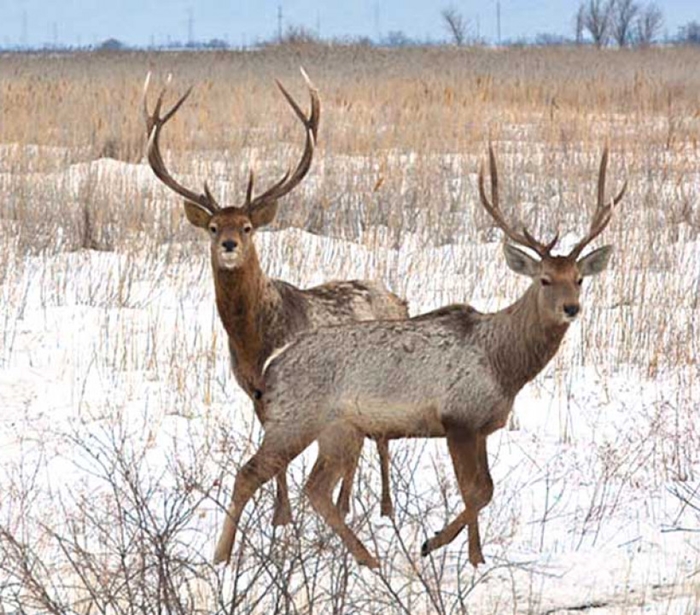Elena Dolgova
The State Nature Reserves of the Ministry of Environmental Protection of Turkmenistan continues preparations for the winter period, which includes biotechnical measures taking into account last year’s February surprises, so that frosty weather conditions do not surprise either employees or residents of protected areas.
Seasonal work includes renovating buildings, inspecting and repairing equipment and machinery, and harvesting stocks of plant herbs and concentrates for feeding animals in aviaries and in nature during frosts. Waste grain products are also collected for wintering waterfowl on the territory of reserves, as these birds can have difficulty finding food when reservoirs and rivers freeze.
Closer to the beginning of winter, fuel, including wood, will be delivered to the cordons to enable planned patrols and work in frosty weather. Inspectors are often left alone with bad weather while on the road, so it is important to have adequate supplies.
The first migratory and flying waterfowl and near-water bird species are now settling on the coast of the Caspian Sea. Some of them will continue to migrate further south, while others will stay for December and January, which are relatively warm. Until the frost strikes, bird flocks are in no hurry to leave the gulfs of the Turkmen part of the Caspian Sea, the islands of the Sarykamysh Lake, or its channels to other lakes in the north of the country. They will be driven further south by the coming waves of Arctic cold.
Before the winter, ecologists prepare to conduct ornithological accounting, primarily on the territory of the wetlands of the Khazar State Nature Reserve, where the largest groups of birds gather.
To ensure a well-fed winter for the compact population of gazelles living on Ogurdjaly island reserve, and to create comfortable conditions for employees during the winter months, all necessary supplies are delivered to the island from the mainland ahead of time. This includes seedlings of woody plants and seeds of halophyte plants for spring forest plantations. With the support of other reserves, sandy acacia, oriental loch, grebe, black saxaul, Euphrates poplar, and gray-leafed poplar seedlings are imported to the island. These plants will serve as food for wild ungulates.
In the Kaplankyr Nature Reserve (Dashoguz province), employees observe the appearance of the first clusters of waterfowl – geese and ducks. They identify and mark areas that will serve as feeders on frosty days, as winter comes early in these northern regions.
Environmentalists are also concerned about the wild ungulates living in the Kaplankyr Nature Reserve. Winter is an important and responsible period for these animals, as the cubs of gazelles, kulans, argali, and saiga are born by spring. If severe winters occur, saigas may migrate to Turkmenistan from the north, fleeing the cold and lack of food.
In the Amu Darya Nature Reserve, employees are preparing a winter treat for deer, consisting of hay from local herbaceous plants. Herb harvesting is now in full swing. Throughout the winter, especially during severe cold spells, the Amu Darya River is jointly monitored by employees of the State Committee of Water Management and inspectors of the reserve. During severe frosts, they control the ice on the sections of the river where a special protection regime is in effect.
In the Badkhyz Reserve, gazelles and argali will find their food along the trails in the Yeroylanduz depression, where the chilling northern winds are least felt. Enough feed is collected annually on the meadow pastures of Garabil to last until spring. Similar events are carried out by employees of all state nature reserves, taking into account local peculiarities.
Employees are also summing up the results of their work in the summer period, when they deal with vegetation monitoring, firefighting measures, and delimiting roads and natural plantings by plowing wide strips. Throughout the summer until the end of October, operational groups of reserve inspectors operated in the reserves. They took turns on duty and were always ready to respond to any incidents.
In mountain reserves, access roads to inaccessible mountain plateaus are currently being restored after rains, natural springs are being cleared, new artificial ones are being created that collect rain moisture, old watering places familiar to animals are being delicately renovated. In a particularly dry hot season, such artificial springs were filled with water.
Another important autumn measure is the counting of ungulates, including grown-up cubs. This helps to assess the increase in the population of these Red Book species. In the Koitendag Nature Reserve, measures to protect Red Book ungulates are yielding results. In recent years, the populations of mountain goats (markhors) and mountain sheep (argali) within the protected area have remained stable with a slight increase. During the last ungulate count, 400 argalis and up to 700 markhors were registered. Observations of other fauna species, especially those listed in the Red Book of Turkmenistan, are also being conducted. ///Neutral Turkmenistan newspaper, 7 November 2023 [Photo credit – Neutral Turkmenistan]
#state_reserves_in_Turkmenistan, #Turkmenistan, #nature_protection

